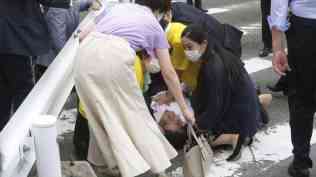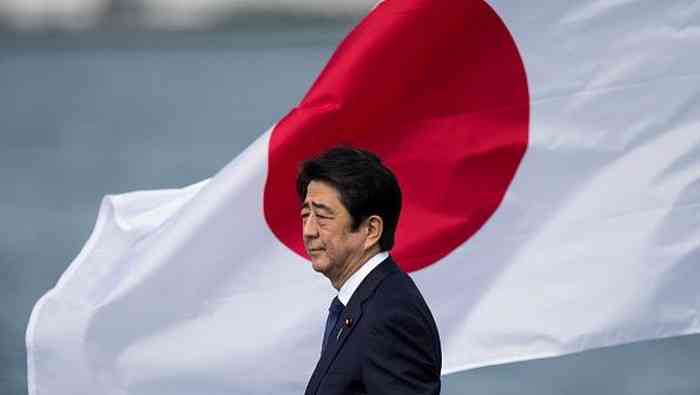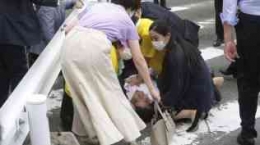Shinzo Abe died after being shot during a speech near Yamato-Saidaiji station, Nara city, Japan on Friday, July 8, 2022 at 11:30 local time. At the time, a single shot was fired from behind Abe and the shot created a puff of smoke.
Shinzo Abe then turned to look over his left shoulder. Soon a second shot followed accompanied by another puff of smoke. Holding his chest, Shinzo Abe then fell to the ground, motionless, and bleeding. According to information explained by the Nara Police, the second shot caused two wounds in the neck and this made the police wonder about what type of weapon and ammunition was used by the perpetrator (Putri, 2022) (Hee Lee & Inuma, 2022).
The cause of Shinzo Abe's death as stated by the Head of the Emergency Center at Nara Medical University Hospital, Hiteda Fukushima explained that Abe showed no vital signs when he arrived at this hospital at 12:20 local time.
According to Fukushima, Abe suffered major damage to his heart along with two neck wounds that damaged his arteries. Despite this, the hospital is still making strenuous efforts to save Shinzo Abe, including conducting massive blood transfusions. It was due to this massive blood loss that Shinzo Abe was pronounced dead less than five hours later from the time of his shooting. Shinzo Abe died at 17:03 local time (Putri, 2022) (Yamaguchi, Tanaka, & Klug, 2022).
Then who was the perpetrator who shot Shinzo Abe during a speech? The shooter is a 41-year-old man named Tetsuya Yamagami who lives in Nara, Japan. He was arrested shortly after the shooting incident occurred, security officers managed to arrest the shooter at the scene. According to Japanese Defense officials, Yamagami is a former member of the Japan Maritime Self-Defense Force or Japan Self-Defense Navy.
He joined the Japan Maritime Self-Defense Force troops for three years. He confessed and said that the motive for shooting Shinzo Abe was because he believed that Shinzo Abe belonged to a group he hated. However, the police refused to explain which group Tetsuya Yamagami was referring to.
From Yamagami's arrest, it was found that the gun he used was homemade, with a gun length of 15 inches or 40 cm. Police also confiscated several weapons that he assembled himself and a personal computer in Yamagami's apartment (Putri, 2022).

So who exactly was Shinzo Abe until he was shot to death? And what influence did Shinzo Abe have on Japanese politics?
Shinzo Abe is the longest serving former Prime Minister of Japan. Shinzo Abe served twice as Prime Minister of Japan, namely from 2006 to 2007, and secondly from 2012 to 2020. Shinzo Abe was born on September 21, 1954, Tokyo, Japan. Shinzo Abe is a member of a prominent political family. His grandfather Nobusuke Kishi served as Prime Minister of Japan from 1957 to 1960, and his great uncle Eisaku Sato held the same post from 1964 to 1972.
After Shinzo Abe graduated from Seikei University in Tokyo in 1977, he moved to The United States, where he studied political science at the University of Southern California, Los Angeles. In 1979, Abe returned to Japan and joined Kobe Steel, Ltd. Abe then became active in the Liberal-Democratic Party (LDP), and in 1982 he began working as a secretary to his father, Shintaro Abe, who was Japan's Foreign Minister at the time (Pletcher, 2022).
In 1993, Shinzo Abe won a seat in the Lower House of The Diet (parliament) and went on to hold a series of government posts. He also gained much support for his tough stance on North Korea, especially after the country revealed in 2002 that it had kidnapped 13 Japanese citizens in the 1970's and 80's.
Abe, who was then Deputy Chief Cabinet Secretary, oversaw the subsequent negotiations. In 2003, Abe was appointed General Secretary of the LDP. Due to LDP term limits, Prime Minister and LDP Leader Junichiro Koizumi was forced to leave his post in 2006, and he was succeeded in both posts by Shinzo Abe. Shinzo Abe then became the country's first Prime Minister born after the Second World War and the youngest since the war (Pletcher, 2022).
As a conservative, when he became Prime Minister of Japan, Shinzo Abe sought to strengthen relations with the United States and pursue a more assertive foreign policy. Abe supported United Nations sanctions against North Korea following the country's nuclear tests and imposed a series of unilateral sanctions on North Korea that included a ban on all visits to Japanese ports by North Korean ships.
Abe also pledged to revise and improve the country's post-war constitution, which imposes strict restrictions on its military. On domestic affairs, Abe promised to shore up the country's pension fund and health insurance system. However, his administration was soon embroiled in a series of public blunders and financial scandals.
In addition, the government drew criticism for its slow response to the discovery that for a decade it had mishandled the pension records of millions of citizens. In July 2007, the LDP lost its majority in the upper house to a coalition led by the Democratic Party of Japan (DPJ), and in September 2007, Abe announced his resignation. He was replaced by Yasuo Fukuda (Pletcher, 2022).
Second term and "Abenomics", Abe retained his seat in the Diet's lower house but in recent years, Abe has remained politically silent, especially after the DPJ-led coalition took over the government in 2009. However, that changed when he was re-elected as LDP leader in September 2009. In 2012, Shinzo Abe's first move was to visit the Yasukuni Shrine in Tokyo, Japan. A memorial to Japan's military dead that includes people convicted of war crimes during World War II.
The move sparked strong protests from other countries in the Asia-Pacific region, and Abe provoked further controversy over his views on the sovereignty of islands in the Pacific disputed between China and Japan, as well as his stance in favor of revised pacifism. A clause in the Japanese constitution.
Despite this, the LDP won a landslide victory in the lower house election on December 16, 2012. On December 26, the new LDP majority in the assembly supported by members of the party's coalition partner, New Komeito, overwhelmingly approved Abe as Prime Minister. He replaced the DPJ's Yoshihiko Noda, who resigned from office that day (Pletcher, 2022).
Abe quickly launched an ambitious economic program intended to stimulate Japan's long moribund economy and help speed the recovery of the northeastern region of Honshu (Tohoku) devastated by the 2011 earthquake and tsunami. The program, quickly dubbed "Abenomics", included measures such as raising the inflation rate, allowing the yen to fall in value against the US dollar and other foreign currencies, and increasing the money supply and government spending on large public works projects. The Abe administration received a major political boost in the July 2013 election for the upper house of the Diet, when candidates from the LDP and its New Komeito allies won enough seats to guarantee them a majority in the chamber (Pletcher, 2022).
Abe's economic program appeared to be successful at first, with strong growth in 2013 and the first half of 2014 and a decline in the unemployment rate. However, the second of three increases in the national consumption (sales) tax (enacted in 2012 by the DPJ-led government) in April 2014 contributed to a dramatic decline in the Japanese economy for the rest of the year. In the fall, the country fell into recession, and Abe's approval ratings plummeted.
He decided to dissolve the lower house and called for snap parliamentary elections, which were held on December 14, 2014. Abe and the LDP won by a large margin, ensuring that he would retain the post of Prime Minister. However, voters showed little enthusiasm for the vote and turned out in very low numbers (Pletcher, 2022).
Following the LDP's strong electoral victory, the Abe administration has actively pursued a revision of Japan's constitution. In 2014 the cabinet had approved a reinterpretation of the constitution's so-called peace clause, which paved the way for passing a bill in May 2015 that would make it easier for Japan to use military force if the country was attacked or threatened.
The bill was subsequently passed by the lower house in July and the upper house in September. Popular opposition to the measures was strong, however, with former Prime Minister, Tomiichi Murayama joining the protesters. The Abe administration has also faced controversy over a proposed new stadium in Tokyo for the 2020 Olympics. The venue design, by architect Zaha Hadid, had initially been accepted but in 2015 was rejected amid fears of ballooning construction costs. Abe's position in the LDP remains strong, however, and in September 2015 he was elected unopposed to another term as party President (Pletcher, 2022).
Although Abe's personal approval ratings have consistently remained below 50 percent since December 2014, the LDP won a landslide victory in the July 2016 election for the upper house of the Diet. The result gave the LDP and New Kmeit a supermajority in both the upper and lower houses, paving the way for constitutional changes that Abe had long advocated. Supporting the LDP was the almost complete collapse of the opposition DPJ, which struggled to present a credible alternative to Abenomics.
A series of scandals in early 2017 pushed Abe's popularity to record lows, but his resurgence in late summer forced him to call snap elections for the lower house in a bid to cement his already formidable majority there. The DPJ, which changed its name to the Democratic Party after merging with the Japan Innovation Party in 2016, effectively elected itself in September 2017. DPJ lawmakers who had planned to contest the October 2017 election were asked to abandon their party affiliation and apply for membership in the Party of Hope, an upstart reform party launched by Tokyo governor and former LDP member Yuriko Koike (Pletcher, 2022).
Pre-election polls put the Party of Hope far behind the incumbent LDP coalition, and Koike further divided the opposition when she introduced a litmus test that excluded liberal candidates. Koike eventually declined to run for a seat in the lower house, and the liberal opposition broke away from the Party of Hope to form the Constitutional Democratic Party.
Abe's political instincts proved correct. Although he remained personally unpopular, the opposition fell apart, and the 2017 election saw the LDP regain a majority lead into both the upper and lower houses of the Diet. Many expected Abe to move forward with his long-promised constitutional revision, but widespread public disapproval led to the measure being postponed indefinitely (Pletcher, 2022).
Abe became Japan's longest-serving prime minister in November 2019, when his tenure surpassed that of Kshaku Katsura Tar, who had served three non-consecutive terms in the early 20th century. In August 2020 Abe announced that he would resign as prime minister due to a recurrence of ulcerative colitis, although he remained in office as caretaker pending the election of his successor. On September 14, 2020, Yoshihide Suga, Abe's chief cabinet secretary, was elected as the new leader of the LDP, and he became prime minister two days later (Pletcher, 2022).
And back in 2013, Shinzo Abe weighed in on security policy, the results of this painstaking and gradual approach can be seen in a number of key areas. These include the establishment of Japan's National Security Council (NSC) in 2013, the passage of a new State Secrecy Law in 2014 and provisions allowing the Japan Self-Defense Forces to participate in collective security operations. There was an increase in Japan's annual defense budget (a 13% increase during Abe's tenure), the development of a more flexible defense doctrine, and the procurement of new military hardware, including F-35 fighters and Izumo-class destroyers capable of enhancing Japan's regional power projection capabilities. Then-Defense Minister Taro Kono spoke ambitiously about the possibility of Japan joining the Five Eyes intelligence partnership between the UK, US, Australia, New Zealand and Canada. This seems to be an indication of how Abe's "pursuit of peace" approach has become the new normal in Japanese foreign policy (Susanti, 2022).
Abe should be credited for his success in maintaining close ties with former US President Donald Trump and using diplomacy as a tool to offset some of the American president's transactional bullying tactics. While Japan remains, like many other US allies, under pressure to increase spending on defense and support for US forces, Abe has avoided a trade war with the US, and the fundamentals of the alliance partnership remain strong. More broadly in terms of foreign policy, Abe has been a diplomatic innovator and demonstrated a capacity for strategic thinking, which marks a sharp change from previous prime ministers, who were often reactive to external events or tended to passively follow Washington's lead. Abe's shift is reflected in a number of new strategic partnerships with India and Australia, defense agreements with Southeast Asian countries, ambitious bilateral foreign and defense partnerships with the UK and France. And the discourse of a new Indo-Pacific vision intended to align economic and security policies with countries spanning the Pacific and Indian Oceans (Susanti, 2022).
Abe's foreign policy innovations were matched by a series of bold multilateral and bilateral trade initiatives, where the prime minister confronted key domestic political constituencies, especially in the agricultural sector. He played a decisive role in strengthening the Trans-Pacific Partnership (TPP-11), securing a trade agreement with the European Union in 2019, which was considered a breakthrough. And negotiated a number of financial and development agreements with China in 2018. Sensibly, while Abe is well aware of the geostrategic threat posed by China, that has not led him to block pragmatic cooperation opportunities with President Xi Jinping. Pragmatism has also underpinned the prime minister's signature "Abenomics" approach to domestic economic management, which allows innovation in the "three arrows" of fiscal, monetary and structural policies (Susanti, 2022).
However, here the successes were less substantive and more about presentation consistent with the Abe administration's focus on messaging and delivery as well. Despite all these notable achievements, Abe's public standing in 2019 suffered a heavy blow after setting an unpopular sales tax hike from 8% to 10% in 2019. Similarly, a series of damaging corruption scandals, partial achievements related to the promise of "womenomics", and in the face of the Covid-19 crisis as well as related disappointments from the postponement of the 2020 Tokyo Olympics (Susanti, 2022).
Shinzo Abe decided to resign after receiving news that his ministers and cabinet had the lowest acceptance rate since 2012. Without a doubt, Abe left the political scene deeply disappointed for not achieving some of his major political ambitions, especially on constitutional revision and territorial dispute settlement, including negotiations with Russia over the post-World War II Northern Territories (Susanti, 2022).
After Shinzo Abe's exit from Japanese politics, the Japanese political scene will remain relatively stable in the short term, as the Liberal Democratic Party is safely in power given the party's majority in both houses of Japan's parliament and the absence of a formal obligation to hold general elections until the fall of 2021. Abe's practical and incremental successes are also consistent with the Liberal Democratic Party's political tradition and offer the safest and least politically controversial foundation for any future leader, who will need to rebuild trust, and expand support from non-ideological Japanese voters in the future. While Abe's aspirations are, at best, his nationalist ambitions partially realized, his pragmatic achievements will likely be his most lasting legacy (Susanti, 2022).
Shinzo Abe also has a good relationship with former US President Donald Trump. It can be seen when Shinzo Abe met Donald Trump when Trump became President-elect in November 2016 which made him the first foreign leader to meet with the former US President, none other than the purpose is to prioritize the US-Japan alliance. Trump withdrew the United States from the Trans Pacific Partnership, a proposed trade agreement with 11 other Pacific nations after Trump threw Abe a curve ball in 2017. Japan took the lead in drafting a successor agreement that did not include the United States (Kwan & Jett, 2022).
Abe was also a driving force in the rise of the Quad, an informal security group consisting of Australia, India, Japan and the United States, as he sought to promote American involvement in the Indo-Pacific region. His efforts to make Japan a stronger presence in global affairs and his nationalism at home have earned Abe much criticism (Kwan & Jett, 2022).
So many contributions made by Shinzo Abe in politics in Japan. Especially in advancing the Japanese economy when he twice served as Prime Minister of Japan. Although there are many controversial treatments by Abe, this is only a political image. May Shinzo Abe rest in peace.
Arigato.
Footnotes:
Hee Lee, M. Y., & Inuma, J. M. (2022, July 7). Japan Shinzo Abe Shot Nara Attack. Retrieved from Washingtonpost.com: https://www.washingtonpost.com/world/2022/07/07/japan-shinzo-abe-shot-nara-attack/
Kwan, R., & Jett, J. (2022, July 8). Shinzo Abe was an undeniably dominant if divisive figure in Japan's modern history. Retrieved from nbcnews.com: https://www-nbcnews-com/news/world/who-was-shinzo-abe-biography-former-japanese-leader-assassinated-rcna37233?_x_tr_sl=en&_x_tr_tl=id&_x_tr_hl=id&_x_tr_pto=sc
Pletcher, K. (2022). Biography Abe Shinzo. Retrieved from Britannica.com: https://www.britannica.com/biography/Abe-Shinzo
Putri, D. L. (2022, July 9). Kronologi dan Penyebab Kematian Mantan PM Jepang Shinzo Abe. Retrieved from Kompas.com: https://www.kompas.com/tren/read/2022/07/09/083000365/kronologi-dan-penyebab-kematian-mantan-pm-jepang-shinzo-abe?page=all
Susanti, S. (2022, July 8). Ini Jejak Pencapaian Shinzo Abe bagi Jepang, Pencapaian Pragmatis Paling Abadi. Retrieved from News.okezone.com: https://news.okezone.com/read/2022/07/08/18/2626021/ini-jejak-pencapaian-shinzo-abe-bagi-jepang-pencapaian-pragmatis-paling-abadi
Yamaguchi, M., Tanaka, C., & Klug, F. (2022, July 9). Japan's ex-leader Shinzo Abe assassinated during a speech. Retrieved from apnews.com: https://apnews.com/article/japan-shinzo-abe-shooting-22ec2248d92304deb9cc46b2142402d2
Baca konten-konten menarik Kompasiana langsung dari smartphone kamu. Follow channel WhatsApp Kompasiana sekarang di sini: https://whatsapp.com/channel/0029VaYjYaL4Spk7WflFYJ2H








